
Selecting the Best ADC for Radar Phased Array Applications: Part 1
Editor's Note: The author has revised this article. The new revision can be found here.
Many papers discuss the system trade-offs and relative merits of digital, analog and hybrid beamforming.1 Building on prior work, this article uses RF-to-analog-to-digital converter (ADC) cascade modeling to show dynamic range (linearity and noise) and sample rate trade-offs against DC power consumption in a multichannel system with varying channel summation in both the RF and digital realms. The optimal selection of sample rate, ADC effective number of bits (ENOB) and RF versus digital channel combining are weighed against DC power consumption. The Schreier and Walden ADC figures of merit (FOMs) are proposed as extensible to a multichannel system to express a single system FOM portraying optimal dynamic range normalized for DC power. Part 2 of this article will analyze the results and draw conclusions from system FOMs.
SYSTEM MODEL INTRODUCTION
In the phased array radar community, full digital beamforming gets a lot of attention. Significant government funding is leading to this capability rapidly evolving and the technique is an industry research hotbed. The promise of omnidirectional arrays with digital beamforming creating simultaneous beams enables software-defined multimission apertures and one array fits many missions. The appeal is multiple independent, simultaneous, software-configurable digital beams that improve detection and enable multifunction.1
In practice, there are multiple challenges to overcome; the biggest being DC power consumption. In elemental digital beamforming, the digitizer node (DAC/ADC) is distributed behind each element and must be of lower DC power than alternatives without sacrificing performance. Digitizer power is a function of dynamic range capability and sampling rate. Choosing the optimal ADC bit resolution and sampling rate, while being cognizant of RF performance, power consumption and digital versus analog beamforming capability is a complicated multidimensional puzzle for phased array system designers.
Thermal limits and size are also factors. Larger phased arrays often employ blades that put the electronics orthogonal to the antenna face, offering thermal and size flexibility. Some systems, especially those at higher frequencies, require electronics that are planar with the antenna and fit within the element lattice spacing. This creates challenging thermal and size problems. The electronics must get smaller and shed power without sacrificing performance.
SYSTEM FIGURES OF MERIT
Dynamic range, or spurious-free dynamic range (SFDR), is the most common receiver FOM and is a function of linearity and sensitivity. Receiver SFDR is different than ADC SFDR. ADC SFDR quantifies the maximum ADC spur among harmonics, interleaving spurs, clock leakage and intermodulation products and is not a direct representation of two-tone linearity. Receiver sensitivity is the minimum detectable signal level at some offset threshold from the noise floor. Considerations like waveform type and probability of detection determine the offset threshold, which is set to zero in this paper. Sensitivity does not consider linearity; it is solely a noise metric. A point of emphasis: radar and electronic warfare (EW) systems operate in blocker environments, so linearity (two-tone intermodulation) is as important as noise. Phased array systems are generally sub-octave and IMD3 distortion is most important. Conversely, EW systems are multi-octave and IMD2 and IMD3 distortion is most important. A radar or EW receiver is typically not optimized only for sensitivity. Linearity is an important design goal and receiver SFDR is a handy FOM because it considers both sensitivity and linearity. Figure 1 illustrates the noise contribution from various processes and components.

Figure 1 Noise contribution of ADC SNDR, NF, IFBW, IMD3 and SFDR.3
SFDR is a single-point FOM that expresses the best-case SNR and distortion at a singular best-case RF input power. This occurs when the IMD spurs are at the same level as the noise.2 SFDR can be expressed as shown in Equation 1:
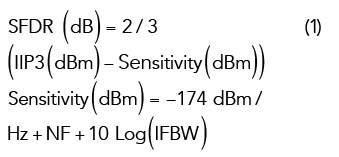
Where the processing bandwidth of the noise channel (IFBW), often set using a combination of IF and digital filtering and the thermal noise spectral density, is ‐174 dBm/Hz at T=290 K.
The model analyzes SFDR and sensitivity system performance FOMs. These metrics are processing bandwidth dependent and the processing bandwidth is set to IFBW=1 Hz. To adjust for the specific processing bandwidth:
- Add 10log(IFBW) to the sensitivity
- Subtract (2/3 x 10log(IFBW)) from SFDR
A receiver often has simultaneous sensitivity and SFDR requirements. Low RF front-end (RFFE) noise figure (NF) helps IP3 and SFDR, but gain helps sensitivity and hurts SFDR. A “Goldilocks” RFFE has enough gain to meet sensitivity requirements but not too much for fear of degrading SFDR. As a rule of thumb; never design a receiver with excess gain.
SYSTEM CASCADE MODEL
The objective is to build a simple Excel model that accommodates swept RF, digital beamforming ratios, ADC ENOB and DC power consumption derived from Murmann survey data. This data will be used to determine the best performance/DC power consumption solution. The cascade model includes the RFFE, channel summation, ADC and digital channel summation. Figure 2 shows the modeled blocks and cascade metrics at each node. The model uses the method for summed RF channel cascade analysis described by Delos et al.4 The key to the model is to track device-additive and cumulative noise spectral density, kTe, at each node and account for signal gain and noise gain separately.

Figure 2 Phased array cascade model using analog and digital beamforming and summation.
Using this model, it is possible to get a negative system NF with summed RF channels, which is exactly the desired advantage of coherent summation as shown in Equation 2:
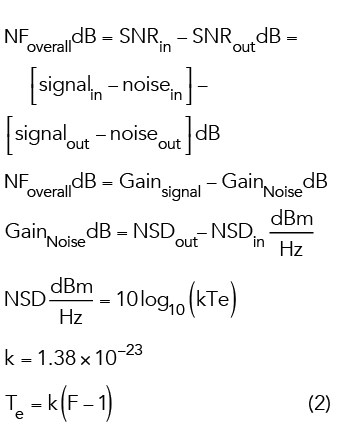
Where F (noise factor)=SNRinput/SNRoutput
NSD = noise spectral density.

The examples use a 64-channel subarray. When plots show channel summation, the horizontal axis ranges from 64-channel digital at the origin to 64-channel RF on the right of the axis, with a blend in between. The blend is called hybrid beamforming with increasing RF sum from left to right. ADC ENOB is swept in the analysis and presented in the plots. Trends in DC power and performance are analyzed as these parameters are swept.
MODELING THE RFFE
The RFFE model is an RF black box with gain, NF, IP3 and DC power that are functions of swept attributes. As the system model sweeps the RF, digital sum ratio and ADC ENOB, the RFFE attributes tune for the best cascade performance. Table 1 provides the attribute function equations.

Figure 3 RFFE gain vs. ADC_ENOB.

Figure 4 Overall sensitivity vs. RFFE gain for varying ENOB.
The model sets RFFE gain as a function of ADC_ENOB, a swept parameter, as shown in Figure 3. The model uses a linear equation to set a minimum viable gain for reasonable system kTe while seeking to maximize SFDR. RF gain reduces SFDR, so it should be minimized to just meet NF requirements. Lower-resolution ADCs have a much higher NF and require more RF gain to set acceptable system NF. In contrast, an ADC with ENOB=12 has excellent NF and requires no front-end gain. This provides a big dynamic range benefit, albeit at an ADC DC power penalty. The effect of sensitivity from RFFE gain and ADC ENOB is shown in Figure 4. Figure 5 shows the gain impact on SFDR for an ADC with ENOB=8 and Figure 6 shows the same analysis for an ADC with ENOB=12. The ENOB=8 case sees improving sensitivity and neutral SFDR impact as the gain is increased to approximately 15 dB. Above 15 dB, SFDR begins to degrade. In contrast, the ENOB=12 case has superior ADC NF, requiring no gain in front. Putting the same 15 dB gain block in front would have a net negative impact on ENOB=12 performance.

Figure 5 RFFE gain impact on SFDR for ADC ENOB=8.

Figure 6 RFFE gain impact on SFDR for ADC ENOB=12.
For these simulations, the RFFE block is set to NF=5 dB and OIP3=30 to 40 dBm. These values are realistic and acknowledge the linearity trade-off. These simulations also assume RFFE filtering, switching, limiting and other loss elements.
The model sets RFFE OIP3 as a function of ADC_IP3 and the number of summed RF ports. The result where every element uses digital beamforming and ADC IP3=22 dBm is shown in Figure 7. This shows that a single port requires an RFFE OIP3 of 30 dB, 8 dB higher than the ADC IP3, for a degradation to system-cascaded IP3 of approximately 0.8 dB. Summing up more RF channels eases the single-channel OIP3 requirement, which eases the RFFE DC power requirement.

Figure 7 RFFE OIP3 vs. the number of summed RF ports.

Figure 8 RFFE DC power/channel.
DC power is an important consideration and the model sets RFFE DC power as a function of RFFE OIP3, which is a function of ADC IP3 and RF sum ports. For the case of RF=1, the RFFE is a variable gain stage with signal filtering. The RF > 1 case sums more than one RF path and the RFFE architecture requires time or phase delay and attenuation control for beamforming. The model assumes a time delay unit (TDU) and a variable attenuator (DATT) between two gain stages. The extra gain stage doubles the DC power, but it is required to overcome the TDU and DATT loss. The results of the analysis are shown in Figure 8, where the doubling of DC power is evident. Figure 8 also shows increasing RFFE DC power with increasing ADC IP3.
MODELING RF CHANNEL SUMMATION
RFFE single-channel OIP3 decreases with increasing RF channel summation. Summing RF channels improves SNR by coherently adding the signal and noncoherent Gaussian white noise. Improved SNR is an advantage, but this creates a larger signal before the nonlinear ADC than digitally summing channels after the ADC. The spur level resulting from multitone intermodulation is a function of ADC IP3 and the signal level into the ADC. For two tones at the same level, Equation 3 specifies:

Summing before the ADC improves SNR but degrades the two-tone spurs due to ADC nonlinearity compared to the same N channels summed digitally after the ADC. The SFDR improves by digitally summing and computing the gain after the ADC. The ADC handles a lower signal and the SNR benefit is realized through the combination of digital data streams at the price of bit growth.

To understand the effects of summing channels, we use a method of passive RF summation developed by Analog Devices.5 With passive summation, there is insertion loss but no additive noise and no impact on IP3. RF summation benefits SNR and has no impact on IP3 because intermodulation spurs add coherently across combined channels, like the signal. Because of RF combiner loss, the sensitivity degrades as the summed channels increase. This is modeled in Equation 4 as:

The RF sum attributes are shown in Table 2.
MODELING THE ADC
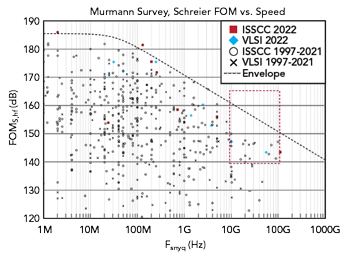
Figure 9 Walden FOM from Murmann survey.

Figure 10 Schreier FOM from Murmann survey.
The ADC model uses behavioral equations derived from Murmann’s ADC survey population data.6 For a valid comparison, near-peer data points from similar-class ADCs are selected using two separate, but similar, FOMs. A black box ADC model allowing swept attributes is created from fitting population data points. The analysis uses two FOMs from the Murmann survey. The Walden FOM (FOMW) shown in Figure 9 favors low-resolution ADCs as it moves 2x per bit. FOMW is calculated in Equation 5 and a lower value is better.

The Schreier FOM (FOMS) shown in Figure 10 favors high-resolution ADCs as they move 4x per bit. FOMS is calculated in Equation 6, and a higher value is better.

As an important rule of thumb, DC power is proportional to the sample rate and exponential with dynamic range for a fixed FOM value.
The points in Figures 9 and 10 represent ADC conference presentations. The dotted “Envelope” line in the charts represents the expectation of commercially available future performance. The most successful ADCs balance dynamic range, sampling rate and DC power requirements.
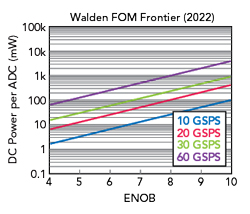
Figure 11 DC power vs. ENOB on the Walden envelope.

Figure 12 DC power vs. ENOB on the Schreier envelope.
Rearranging the FOM equations results in Equation 7. This data is plotted as DC power versus ENOB for the Walden FOM in Figure 11 and the Schreier FOM in Figure 12. These charts show how to trade off power and ENOB to arrive at the same FOM.
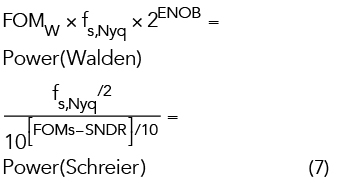
The attractiveness of a high speed ADC in an application involves a trade-off of ENOB, ISBW and DC power. Simultaneously excelling in all is very difficult. For example, a maximum DC power limit of 100 mW per ADC requires a compromise in sampling rate and ENOB for the application. At 60 GSPS, a state-of-the-art ADC will be ENOB=6. Lowering the sampling rate to 10 GSPS increases the ADC dynamic range to ENOB=8.7. Both ADCs are considered state-of-the-art, but the best solution depends on system priorities.
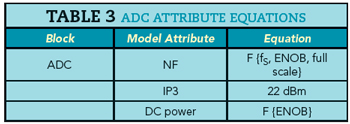
High sampling rate converters offer benefits in areas like frequency planning, instantaneous coverage, software-defined digital tuning and RF simplification. To fully understand the implications, designers must also understand DC power consumption and ENOB. The dynamic range, sampling rate and DC power consumption “triangle” determine overall ADC merit. In a radar application, for example, 60 GSPS at ENOB=6 might not be a better solution than 10 GSPS at ENOB=8.7. A high sampling rate might look attractive, but ENOB and power limit are often higher system priorities.
The ADC performance cascade model uses an RF black box with attributes NF, IP3 and DC power as shown in Table 3. These ADC attributes change as the system model sweeps.
The ADC NF is a function of ENOB or SNR as shown in Equation 8:

Noise spectral density, kTe (dBm/Hz), is equivalent to sensitivity (dBm) in a 1 Hz bandwidth. A 1 Hz bandwidth is assumed throughout, but this can be adjusted by adding a 10LogBW term. While this analysis focuses on noise, ADC two-tone IP3 performance is also important.

Figure 13 ADC DC power vs. ENOB.

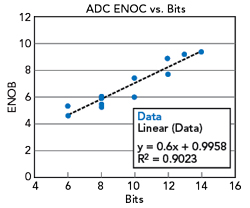
Figure 14 ENOB vs. bits.
The ADC DC power model uses data summarized in the Murmann survey. Figure 13 reduces the Murmann ADC survey data (rev20220719) to 20 members and filters for Analog Devices and industry peers, CMOS < 32 nm and fS>=4 GSPS to show the data and extrapolation of DC power as a function of ENOB. The curves in Figure 13 come from substituting the values of Table 4 into Equation 9.

Using the selected set of Murmann data, the model derives a relation for ENOB as a function of bits as shown in Equation 10 and plotted in Figure 14.

These equations describe a DC power and RF attribute model for the ADC as a function of ENOB. This is shown in Figure 15. Figure 16 shows DC power/channel versus ENOB in a system using digital beamforming.
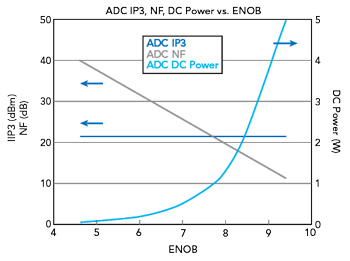
Figure 15 ADC NF, DC power and ENOB.

Figure 16 Beamforming trade-offs.
MODELING THE DIGITAL PAYLOAD

Table 5 Naval ships at the ready.
The high speed data payload and sum computation DC power are estimated from the transport energy per bit.6 The digital payload transport power associated with the ADC-to-digital sum node scales up as the number of digital sum channels and IBW increases. Table 5 shows the digital sum model attributes and Equation 11 calculates the high speed interface physical link transport DC power.

Equation 12 assumes a JESD link:


Figure 17 DC power response.
Figure 17 plots the DC power/channel including the interface versus summed RF channels for various ADCs.
CONCLUSION
Every phased array system has different beam attributes, sensitivity and dynamic range requirements for given DC power limits. A continuum of performance versus DC power solutions exists, but the best solution depends on the mission requirements. This article constructs an RF cascade model for a phased array receiver that analyzes the impact of RF and digital channel summation on dynamic range and DC power. The Excel model includes:
- RFFE
- RF channel summation
- ADC
- High speed digital interface and compute
- Digital channel summation.
Part 2 will present and analyze model results, relate the results to system FOMs and draw conclusions.
References
- T. H., Salvador, K.W. O’Haver, T. M. Comberiate, M. D. Sharp and O. F. Somerlock, “Benefits of Digital Phased Array Radars.” Proceedings of the IEEE, Vol. 104, No. 3, February 2016.
- W. F. Egan, “Practical RF System Design,” John Wiley & Sons.
- B. Annino, “SFDR Considerations in Multi-Octave Wideband Digital Receivers.” Analog Dialogue, Vol. 55, No.1, January 2021.
- P. Delos, S. Ringwood and M. Jones,“ Hybrid Beamforming Receiver Dynamic Range Theory to Practice,” Analog Devices, Inc., November 2022.
- www.analog.com/en/technical-articles/hybrid-beamforming-receiver-dynamic-range.html.
- B. Murmann, “ADC Performance Survey 1997–2022,” GitHub, Inc., 2023.
